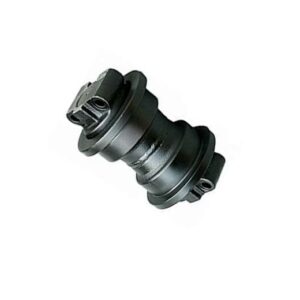Track rollers and carrier rollers are parts that you can usually find in tracked vehicles like crawlers, bulldozers, and excavators. Track rollers and carrier rollers have contrasting roles and work in different areas even though they do the same thing in the undercarriage system.
- Track Rollers:
- Function: Track rollers are alternate called bottom rollers or track idlers. These parts absorb the weight of the machine and the track chain tension. They roll across the ground surface and also help in directing the track chain around the undercarriage frame.
- Location: Track rollers are found on the underside of the track frame, which are placed at even intervals across its length.
- Design: Text to be rewritten: “Track rollers are cylindrical in shape and are mounted on shafts or bolts that attach to the track frame. They often have sealed bearings or bushings to withstand the heavy loads and abrasive conditions encountered during operation.” Rewritten text: “Track rollers have a cylindrical appearance and are mounted on shafts or bolts that connect to the track frame. Usually, they contain sealed bearings or bushings for surviving in heavy loads and abrasive situations under work.”
- Features: Track rollers experience a lot of rubbing and they are intended to spread out the mass of the equipment across the track chain in an even way that will prevent irregular rubbing minimize tension on undercarriage parts.
- Carrier Rollers:
- Function: Carrier rollers serve to guide and support the track chain from the top side of the undercarriage. They maintain proper track tension and alignment also referred to as top or upper rollers.
Location: They are located at the top of track frame commonly positioned at the rear or centre point of undercarriage mounted on bracket that attaches on frame.
Design: They might be larger in diameter as compared to track rollers and might have flanged design so as to prevent lateral motion of the track chain. Carrier rollers also may have sealed bearings or bushings that endure loads and give smooth rolling action. - Features: Carrier rollers help to distribute the weight of the machine across the track chain, particularly during turning or uneven terrain conditions. They play a crucial role in maintaining proper track tension and alignment, which is essential for smooth operation and extended undercarriage life.
- Function: Carrier rollers serve to guide and support the track chain from the top side of the undercarriage. They maintain proper track tension and alignment also referred to as top or upper rollers.
To sum it up, though both track rollers and carrier rollers constitute important aspects of an undercarriage system for a tracked vehicle, these two types of rollers differ significantly in terms of where they are located as well as their functions and designs. The weight of the machine is supported and the track chain is guided on the bottom side of the undercarriage by track rollers while carrier rollers support and guide the track chain from the top side. Therefore, both of them function together to ensure that operation is lubricated, tension is done in the right way for tracks and undercarriage life is increased.

Comments